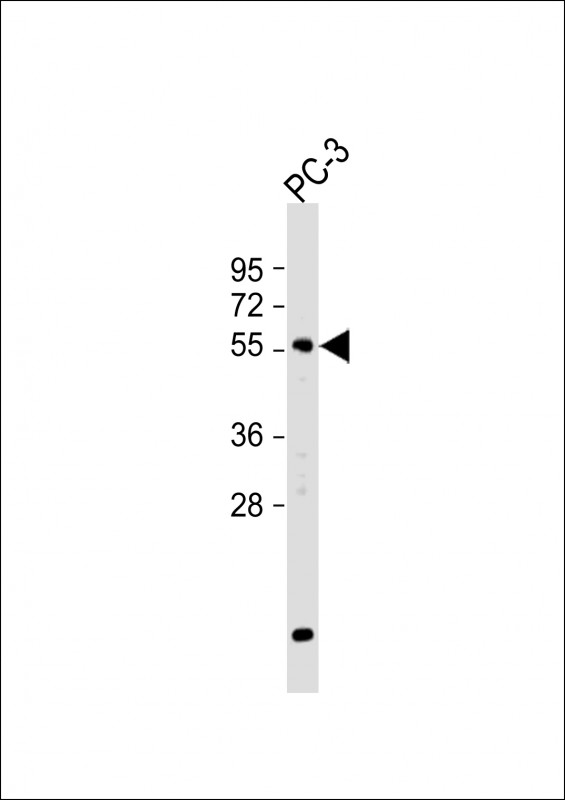
| WB | 1/500 | Human,Mouse,Rat |
| IF | 咨询技术 | Human,Mouse,Rat |
| IHC | 咨询技术 | Human,Mouse,Rat |
| ICC | 技术咨询 | Human,Mouse,Rat |
| FCM | 咨询技术 | Human,Mouse,Rat |
| Elisa | 咨询技术 | Human,Mouse,Rat |
| Aliases | Transmembrane glycoprotein NMB, Transmembrane glycoprotein HGFIN, GPNMB, HGFIN, NMB |
| Entrez GeneID | 10457 |
| WB Predicted band size | 63.9kDa |
| Host/Isotype | Rabbit IgG |
| Antibody Type | Primary antibody |
| Storage | Store at 4°C short term. Aliquot and store at -20°C long term. Avoid freeze/thaw cycles. |
| Species Reactivity | Human |
| Immunogen | This GPNMB antibody is generated from rabbits immunized with a KLH conjugated synthetic peptide between 541-569 amino acids from the C-terminal region of human GPNMB. |
| Formulation | Purified antibody in PBS with 0.05% sodium azide. |
+ +
以下是关于GPNMB抗体的3篇代表性文献及其摘要概括:
---
1. **文献名称**:*Glycoprotein nonmetastatic melanoma protein B (GPNMB) as a therapeutic target in cancer*
**作者**:Kuan CT, et al.
**摘要**:该综述总结了GPNMB在多种肿瘤(如黑色素瘤、胶质母细胞瘤、乳腺癌)中的过表达现象,探讨其作为治疗靶点的潜力,并分析了基于GPNMB抗体的靶向治疗策略(如抗体药物偶联物)的临床前研究进展。
---
2. **文献名称**:*CDX-011 (Glembatumumab Vedotin) for metastatic breast cancer: Phase II clinical trial results*
**作者**:Yao H, et al.
**摘要**:本文报道了靶向GPNMB的抗体药物偶联物CDX-011在转移性三阴性乳腺癌患者中的II期临床试验结果,显示其对GPNMB高表达患者的肿瘤抑制效果显著,并讨论了其作为精准治疗药物的潜力。
---
3. **文献名称**:*GPNMB modulates α-synuclein neurotoxicity in Parkinson’s disease models*
**作者**:Moloney EB, et al.
**摘要**:该研究揭示了GPNMB在帕金森病中的作用,发现抗GPNMB抗体可减少α-突触核蛋白的异常聚集和神经炎症反应,提示其在神经退行性疾病治疗中的应用前景。
---
以上文献涵盖肿瘤靶向治疗、抗体药物开发及神经疾病机制等方向,反映了GPNMB抗体的多领域研究价值。
GPNMB (Glycoprotein Non-Metastatic Melanoma Protein B), also known as osteoactivin or HGFIN, is a transmembrane glycoprotein involved in cell adhesion, differentiation, and tissue repair. Structurally, it contains an RGD motif for integrin binding and a cytoplasmic domain linked to intracellular signaling. GPNMB is expressed in various tissues, including melanocytes, osteoclasts, and immune cells, and is notably overexpressed in cancers (e.g., melanoma, glioblastoma, triple-negative breast cancer), neurodegenerative diseases, and inflammatory conditions. Its dual role in promoting tumor progression (via angiogenesis, metastasis) and modulating immune responses makes it a compelling therapeutic target.
GPNMB-targeting antibodies, particularly monoclonal antibodies (mAbs), have emerged as promising tools. In oncology, antibody-drug conjugates (ADCs) like glembatumumab vedotin (CDX-011), which links an anti-GPNMB mAb to the cytotoxic agent monomethyl auristatin E, have shown antitumor activity in clinical trials. These antibodies exploit GPNMB's cancer-specific overexpression to deliver targeted therapy while sparing healthy tissues. In non-oncological contexts, GPNMB antibodies are explored for treating conditions like osteoarthritis or neurodegenerative disorders, where GPNMB modulates inflammation or protein aggregation (e.g., α-synuclein in Parkinson’s disease). Diagnostic applications include using GPNMB antibodies as biomarkers for disease stratification or monitoring treatment response. Challenges remain in optimizing specificity and managing off-target effects, but GPNMB antibodies represent a versatile platform for precision medicine.
×